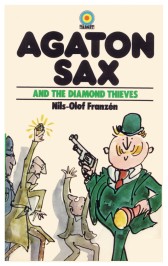Agaton Sax facts for kids

Agaton Sax is a super smart detective from a series of funny Swedish books. These books were written by Nils-Olof Franzén for children. They are all about Agaton Sax solving exciting mysteries. The English versions of the books have cool drawings by Quentin Blake.
The stories are a bit like a funny version of classic detective tales. For example, Agaton Sax's friend, Inspector Lispington from Scotland Yard, reminds us of Inspector Lestrade from the Sherlock Holmes stories. Just like Holmes, Agaton Sax smokes special pipes when he is thinking hard. He even has a different Meerschaum pipe for every day of the week!
Nils-Olof Franzén wrote these stories for his son. He even helped translate most of them into English himself. This helped keep the humor from the original Swedish books. The books became very popular in the UK. They were re-released many times, making them a top detective series for kids in Britain.
Contents
The Agaton Sax Books
There are eleven Agaton Sax books in total. Most of them were also published in English. Here is a list of the books and when they came out:
| Swedish title | Published | English title | Published |
|---|---|---|---|
| Agaton Sax klipper till | 1955 | Agaton Sax and the Big Rig (revised) | 1976 |
| Agaton Sax och den ljudlösa sprängämnesligan | 1956 | Agaton Sax and the League of Silent Exploders | 1974 |
| Agaton Sax och vita möss-mysteriet | 1957 | Agaton Sax and the Haunted House | 1975 |
| Agaton Sax och de slipade diamanttjuvarna | 1959 | Agaton Sax and the Diamond Thieves | 1965 |
| Agaton Sax och det gamla pipskägget | 1961 | Agaton Sax and the Scotland Yard Mystery | 1969 |
| Agaton Sax och Byköpings gästabud | 1963 | Agaton Sax and the Criminal Doubles | 1971 |
| Agaton Sax och bröderna Max | 1965 | Agaton Sax and the Max Brothers (also known as Bank Robbers) | 1970 |
| Agaton Sax och den bortkomne mr Lispington | 1966 | Agaton Sax and the Colossus of Rhodes | 1972 |
| Agaton Sax och de okontanta miljardärerna | 1967 | Not published in the UK | |
| Agaton Sax och den svällande rotmos-affären | 1970 | Agaton Sax and the London Computer Plot | 1973 |
| Agaton Sax och den mörklagda ljusmaskinen | 1978 | Agaton Sax and Lispington's Grandfather Clock | 1978 |
Main Characters
Who is Agaton Sax?
Agaton Sax is the main character of the series. He is a friendly, round Swedish man with a moustache. He runs his own detective agency. He also runs the local newspaper, the Bykoping Post. Its motto is: First with the News - The Smallest Paper - but the Best.
Agaton Sax gets help from his dog, Tikkie, and his Aunt Matilda. They help him catch bad guys like Octopus Scott. He is very good at underwater ju-jitsu. He also knows many unusual languages. Agaton Sax was one of the first detectives to use a computer to solve crimes. His Aunt Matilda calls it his "confuser." He does not like garlic at all.
Chief Inspector Joshua Lispington
Inspector Lispington is a police officer from Scotland Yard. He often tries to help Agaton Sax. But he can be a bit clumsy and gets into trouble. Even though he makes mistakes, he is always Agaton Sax's friend.
Aunt Matilda
Aunt Matilda takes care of Agaton. She cooks for him and keeps him company. People often think she is just an old lady. But she can be very tough when she needs to be! She often uses everyday things to fight criminals. Her favorite weapon is her umbrella.
Tickie the Dog
Tickie is Agaton Sax's loyal dachshund dog. Tickie sometimes joins Agaton on his crime-solving adventures. Tickie is well-trained and usually very helpful.
Clever Dick
Clever Dick is Agaton Sax's special computer. Agaton built it himself to help him solve mysteries. Aunt Matilda likes to call it a "confuser."
Sergeant Antonsson
Sergeant Antonsson is the acting head of the Bykoping Police. He often helps Agaton Sax and Inspector Lispington with their investigations.
TV Shows and Movies
The Agaton Sax books were made into TV shows and even a movie!
Three of the books were turned into TV segments for the BBC children's show Jackanory. This happened between 1972 and 1981. Kenneth Williams was the storyteller. He would read a shorter version of the book. He also used his voice and face to act out the different characters. The show also used the original drawings by Quentin Blake.
In 1972, an animated TV series was made in Sweden. It was based on the book Agaton Sax and the Max Brothers. The BBC showed it in 1976. The famous BBC actor Peter Hawkins did the voices for the characters.
An animated movie called Agaton Sax och Byköpings gästabud was made in Swedish in 1976. The story was based on Agaton Sax and the Criminal Doubles. The BBC showed an English version of this movie in 1978. It was called Agaton Sax and The Feast at Bykoping. Kenneth Williams again did all the voices for the characters.
The Agaton Sax adaptations were shown many times on BBC1. This helped the character become even more popular in the UK. This was around the same time the English books were being published.

